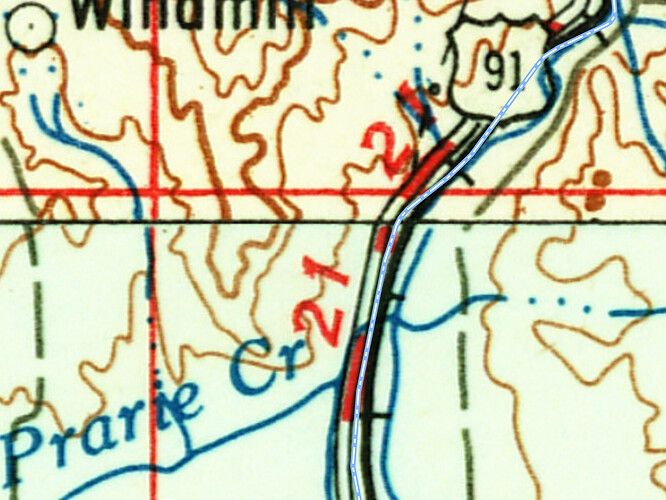Well, that was true when I wrote it, but you all nerd-sniped me hard enough to send me on a monthlong detour into time zone mapping. ![]()
I spent most of the month drawing the old boundaries from scratch based on railroad tracks rather than any kind of administrative boundary. Actually, not the tracks themselves, but rather the edges of the rights of way of those tracks, some of them already abandoned or submerged under a reservoir at the time, unbeknownst to the federal government. Despite having gotten a firsthand look at the darkened crop lines and suspected embankments that OSM’s abandoned railway mappers swear by, I still don’t really get the appeal for them in OSM when something like this can happen to a mainline:
As excited as I am about OHM becoming a destination for exotic geographic knowledge, OSM’s definition of a “time zone” differs enough from OHM’s that the two projects will continue to complement each other for the foreseeable future. OSM’s boundary=timezone relations and timezone=* tags on administrative boundary relations make it relatively straightforward to determine the correct Internet time zone for a given place in the present day:
By constrast, OHM takes a longer view that will be useful for placing events further back in history – that is, once Wikidata figures out how to modeling daylight saving time and other quirks of observed time that don’t necessarily conform to boundaries. OHM is more interested in real-world history than the history of the tz database, but that database has such an impact on modern life that OSM benefits from integrating with it even more than from covering some real-world boundaries.
Having gone through this exercise, I’m not inclined to replicate in OHM the giant, pole-to-pole “time zone” boundaries that prompted this thread’s revival. Real time zone boundaries don’t fit into that model very well, and others have noted the unnecessarily high maintenance overhead associated with them. I mean, even the puny U.S. time zone boundaries forced me out of iD and into JOSM – that’s saying something.
Incidentally, I noticed that @Arctic_gnome has experimented with transnational timezone_master relations. What is the intended definition of this relation type? The “Eastern Time Zone” boundary relation still seems to model more or less the pole-to-pole UTC−5 region, including not only the jurisdictions that call it the Eastern Time Zone but also those that define a matching time offset as a national civil time. It could be a workable alternative to the pole-to-pole relations, but a different name would avoid some confusion.

